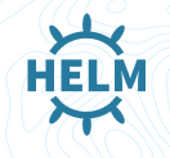| Helm 3.0 Released |
| Written by Kay Ewbank | |||
| Monday, 02 December 2019 | |||
|
Helm 3.0 has been released with Tiller removed and the Helm Go SDK refactored for general use. Helm is a package manager for Kubernetes designed to allow developers and operators to more easily package, configure, and deploy applications and services onto Kubernetes clusters. Now an official Kubernetes project, Helm is part of the Cloud Native Computing Foundation, a non-profit organisation that supports open source projects for the Kubernetes ecosystem.
Helm aims to remove the complexity of managing the objects in Kubernetes such as ConfigMaps, services, pods, and Persistent Volumes, along with your own releases. Kubernetes Helm can be used to package everything into one simple application. Helm uses charts, collections of files that describe a related set of Kubernetes resources. A single chart might be used to deploy something simple, like a memcached pod, or something complex, like a full web app stack with HTTP servers, databases, caches, and so on. Helm comes with a collection of over 100 pre-defined Helm Charts covering uses including MySQL, MariaDB, and WordPress. One main change to the new release of Helm is that it no longer uses Tiller. In Helm 2, the developers introduced Tiller, an in-cluster component of Helm that interacted directly with the Kubernetes API server to install, upgrade, query, and remove Kubernetes resources. However, as Kubernetes 1.6 introduced role-based access controls (RBAC) enabled by default it become more difficult to use Tiller because of the number of security policies, and its primary goal could be accomplished by simply fetching information from the Kubernetes API server, rendering the Charts client-side, and storing a record of the installation in Kubernetes. Tiller has therefore been removed and the security model for Helm is simplified. Another change is that the Helm Go SDK has been refactored for general use, with the aim of making the code available to the broader Go community Some features have also been added. Helm now uses three-way strategic merge patches. Helm 2 used a two-way strategic merge patch that meant it could be difficult to roll back changes during an upgrade. Helm 3 uses a three-way strategic merge patch. Helm now considers the old manifest, its live state, and the new manifest when generating a patch, making it easier to roll back a release if necessary. Another improvement is that release names are now scoped to the namespace. In Helm 2, the information about each release was stored in the same namespace as Tiller, which in practice meant that once a name was used by a release, no other release could use that same name, even if it was deployed in a different namespace. In Helm 3, release information about a particular release is now stored in the same namespace as the release itself. This means that users can use separate workspaces.
More InformationRelated ArticlesKubernetes For Full Stack Developers Kubernetes Security Audit Open Sourced Red Hat Launches Quarkus For Kubernetes-Native Apps To be informed about new articles on I Programmer, sign up for our weekly newsletter, subscribe to the RSS feed and follow us on Twitter, Facebook or Linkedin.
Comments
or email your comment to: comments@i-programmer.info |
|||
| Last Updated ( Tuesday, 03 December 2019 ) |



